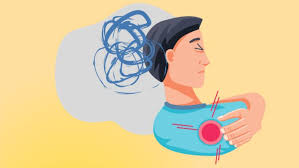Chronic pain and depression are two debilitating conditions that often coexist, creating a complex interplay that significantly impacts an individual’s physical, emotional, and social well-being.
While they are distinct disorders, their relationship is deeply intertwined, with one often exacerbating the other.
This article aims to explore the intricate link between chronic pain and depression, shedding light on the biological, psychological, and social factors that contribute to their co-occurrence.
The Biological Basis
At the core of the relationship between chronic pain and depression lies a complex interplay of biological mechanisms. Both conditions involve alterations in neurotransmitter systems, such as serotonin, norepinephrine, and dopamine, which play crucial roles in regulating mood, pain perception, and emotional responses.
Dysfunction in these systems can lead to heightened pain sensitivity and dysregulated mood, creating a vicious cycle wherein pain exacerbates depressive symptoms, and vice versa.
Moreover, chronic pain is associated with neuroinflammation, whereby persistent pain signals trigger an inflammatory response in the central nervous system.
This neuroinflammatory process not only contributes to the maintenance of pain but also affects brain regions implicated in mood regulation, such as the prefrontal cortex and limbic system.
Consequently, individuals experiencing chronic pain are at an increased risk of developing depressive symptoms due to the shared neurobiological pathways underlying both conditions.
Psychological Factors
Psychological factors also play a significant role in the relationship between chronic pain and depression. The experience of enduring pain over an extended period can lead to feelings of helplessness, hopelessness, and loss of control, which are hallmark features of depression.
Moreover, the constant struggle to cope with pain can disrupt sleep, impair cognitive function, and diminish quality of life, further contributing to the development of depressive symptoms.
Conversely, individuals with pre-existing depression may be more susceptible to developing chronic pain due to alterations in pain processing and increased sensitivity to stress.
Chronic stress, a common trigger for depression, can exacerbate pain by heightening the body’s inflammatory response and lowering the pain threshold. Thus, the presence of depression can amplify the experience of pain, making it more challenging to manage and cope with.
Social and Environmental Influences
Social and environmental factors also play a crucial role in shaping the relationship between chronic pain and depression. Chronic pain can disrupt social relationships, limit participation in meaningful activities, and impose financial burdens, leading to social isolation, stigma, and feelings of inadequacy.
These psychosocial stressors can exacerbate depressive symptoms, creating a vicious cycle wherein pain-induced social withdrawal further perpetuates feelings of loneliness and despair.
Furthermore, socioeconomic disparities can exacerbate the impact of chronic pain and depression, with individuals from disadvantaged backgrounds facing greater barriers to accessing healthcare, adequate pain management, and mental health support.
Lack of social support, unstable living conditions, and limited access to resources can amplify the burden of chronic pain and contribute to the development of depression in vulnerable populations.
Treatment Implications
Given the complex interplay between chronic pain and depression, effective treatment requires a comprehensive approach that addresses both conditions simultaneously.
Integrated interventions that combine pharmacotherapy, psychotherapy, and interdisciplinary pain management techniques have shown promising results in improving outcomes for individuals with comorbid chronic pain and depression.
Medications targeting both pain and depression, such as selective serotonin reuptake inhibitors (SSRIs), serotonin-norepinephrine reuptake inhibitors (SNRIs), and tricyclic antidepressants (TCAs), can help alleviate symptoms and restore neurotransmitter balance.
Cognitive-behavioral therapy (CBT), mindfulness-based stress reduction (MBSR), and acceptance and commitment therapy (ACT) are effective psychotherapeutic approaches for addressing maladaptive pain coping strategies, negative thought patterns, and emotional distress.
Furthermore, complementary and alternative therapies, such as acupuncture, yoga, and massage therapy, can provide additional benefits in managing pain and improving mood.
However, individualized treatment plans tailored to the unique needs and preferences of each patient are essential for optimizing outcomes and promoting long-term recovery.
Conclusion
The link between chronic pain and depression is multifaceted, involving complex interactions between biological, psychological, and social factors.
Understanding the interconnected nature of these conditions is crucial for developing effective treatment strategies that address the underlying mechanisms driving their co-occurrence.
By adopting a holistic approach that integrates medical, psychological, and social interventions, healthcare providers can better support individuals living with chronic pain and depression, enhancing their quality of life and promoting overall well-being.

Leave a comment